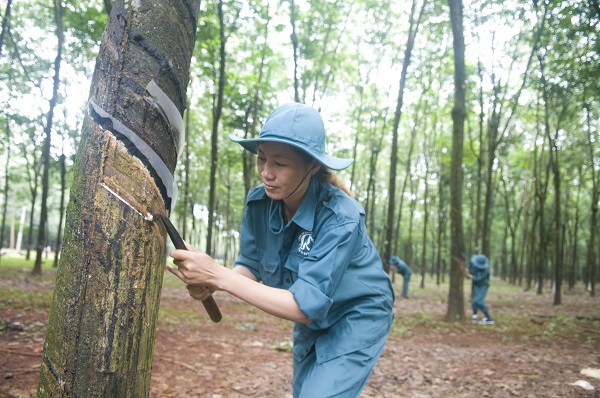Vietnam vows to remove investment hurdles with Laos
 |
| photo Le Toan |
At a meeting organised a few days ago between the government and Vietnam-Laos Co-operation Committee, Prime Minister Nguyen Xuan Phuc stated that Vietnam will further its bilateral investment co-operation with Laos this year, with a focus on implementing co-operation projects about seaports, electricity, and infrastructure.
Focus will also be placed on boosting the implementation of delayed Vietnamese investment projects in Laos.
“It is necessary to review some projects in Laos so that their construction can be boosted with the highest responsibility. All enterprises and investors failing to implement the projects effectively must be strictly punished,” Phuc said.
During his bilateral meeting with his Lao counterpart Thoongloun Sisoulith in Cambodia more than one week ago, Phuc committed that Vietnam will create the most favourable conditions for Laos to exploit Vung Ang seaport.
A few years ago, the two countries inked an agreement on using this seaport, with the 2011 establishment of Lao-Viet International Port JSC in charge of using the port’s wharves 1, 2, and 3 to transport goods from the port to Laos.
Wharves 1 and 2 have become operational in 2001 and 2010. Meanwhile, wharf 3 is under construction by this company and is expected to be put in operation in 2019.
Besides, wharves 4, 5, and 6 will also be constructed in the near future by local and foreign firms.
According to a document on Vietnam’s investments in Laos sent to VIR by the Department of Foreign Economic Relations (DFER) under Vietnam’s Ministry of Planning and Investment (MPI), Vietnam currently has 276 valid investment projects in Laos, registered at about $5 billion, $1.6 billion of which has been disbursed. If loans from Vietnam’s banks are taken into account, the disbursed sum is $1.8 billion. Laos is Vietnam’s biggest overseas investment destination.
Vietnam’s investments in Laos are focused largely on the hydropower sector, with the total capital of $1.47 billion, or 29.4 per cent of Vietnam’s total investments in Laos, followed by the services and infrastructure sector (over $1 billion or 20 per cent), the mining sector ($970 million or 19.38 per cent), the agri-forestry sector ($903.5 million or 18 per cent), and other sectors like property, finance, and banking.
According to statistics from Laos, in the hydropower sector, Laos have inked memoranda of understanding with Vietnamese firms to implement 15 projects in Laos, with the total designed capacity of over 3,000 megawatts (MW), and the total investment capital of about $5.4 billion.
Of this, MPI has granted overseas investment licences to six projects with the total capacity of 1,008MW and total capital of $1.47 billion, including Sekaman 1 (290MW), Sekaman 3 (250MW), Nam Cong 2 and 3 (total 110MW), Se Kong 3A and 3B (total 205MW), and Nam Mo (120 MW).
However, “Reviewing results showed that many [hydropower projects] have failed to be implemented as per the investors’ commitments to the Lao government. Some projects’ MoUs have been extended many times, while the MoUs of some projects have passed their deadlines and have been revoked by the Lao government (such as Se Kong 3A and 3B, and Nam Mo),” said the document.
In another case, Vietnam’s biggest Laos-based investment project which is to exploit and process potassium salt, begun construction last year. The $522.5-million project, invested by Vietnam National Chemical Group, will use potassium salt as material to produce potassium fertiliser. However, only 30 per cent of the plant’s construction has been completed, with over $74 million disbursed.
“The project is faced with difficulties due to the plummeting price of potassium in the world market, falling from $480 to only $250 per tonne, while there is no sign of it bouncing back. This has made the project ineffective and the investor cannot mobilise capital for further implementation,” said the document. “The Vietnamese government and the prime minister have organised many meetings with ministries and Vinachem to alleviate the project’s difficulties.”
What the stars mean:
★ Poor ★ ★ Promising ★★★ Good ★★★★ Very good ★★★★★ Exceptional
Latest News
More News
- Viettel Global sets new profit record with sustained overseas growth (October 30, 2025 | 08:00)
- Coteccons charts course for regional expansion (October 22, 2025 | 17:06)
- Green GSM drives VinFast EV expansion into the Philippines with Xentro (October 10, 2025 | 18:11)
- Vietnamese investors pour nearly $847 million into overseas markets in nine months (October 08, 2025 | 18:42)
- VinFast India joins forces with State Bank of India for EV financing (October 02, 2025 | 10:05)
- MoF backs reforms to cut red tape for overseas investment (September 29, 2025 | 09:00)
- Singapore becomes launchpad for Vietnamese SMEs (September 16, 2025 | 16:16)
- Hong Kong's Tevo forms strategic partnership with MobiFone Global (September 11, 2025 | 17:46)
- Overseas investments increase 3.8 times in first eight months (September 10, 2025 | 10:02)
- FPT boosts presence in South Korea (August 27, 2025 | 10:23)


















 Mobile Version
Mobile Version